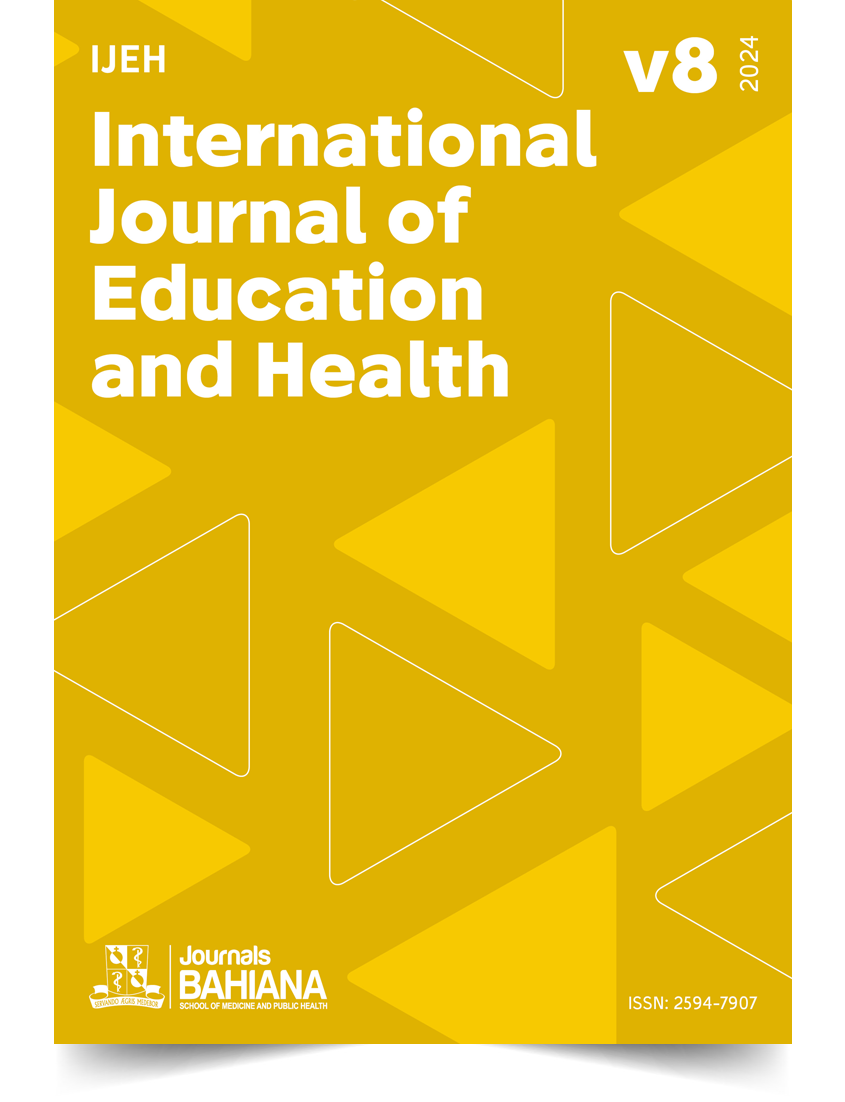Realistic simulation and gamification in first aid for the Physiotherapy course
DOI:
https://doi.org/10.17267/2594-7907ijeh.2024.e5415Keywords:
Simulated Training, Teaching, First AidAbstract
INTRODUCTION: First aid is the initial procedures and measures provided to victims of sudden or traumatic illness from the location of the event until the arrival of the specialized emergency service. One of the ways to learn first aid is through teaching based on realistic simulation. OBJECTIVE: To describe training based on simulation and gamification used in first aid classes with second-semester physiotherapy students. METHODOLOGY: This is a descriptive study with a qualitative approach. Theoretical-practical activities were developed with physiotherapy students in the classroom and the simulation laboratory. In the classroom, the teacher presented and discussed the concepts of different situations in which first aid is applied. For practical classes, clinical cases were proposed in which students should perform appropriate actions on the mannequins or themselves, depending on the simulated situation. To measure the perception of these students, they were asked to respond to a validated questionnaire called the Satisfaction Scale with Simulated Clinical Experiences. RESULTS: The present work showed that, in general, students were satisfied with the simulated practical classes despite three items in the questionnaire having obtained lower percentage marks. CONCLUSION: According to the academics' responses to the questionnaire items, simulation-based teaching should be encouraged in undergraduate physiotherapy courses due to the potential benefits described in this work.
Downloads
References
(1) Moura TVC, Araújo AL, Rosa GS, Castro JJV, Silva ARV. Educational practices in first aid: extension experience report. Rev Ciênc Ext [Internet]. 2018;14(2);180-7. Available from: https://ojs.unesp.br/index.php/revista_proex/article/view/1644
(2) Carbogim FC, Luiz FS, Oliveira LB, Braz PR, Santos KB, Püschel VAA. Effectiveness of a teaching model in a first aid course: a randomized clinical trial. Texto Contexto Enferm. 2020;29:e20180362. https://doi.org/10.1590/1980-265X-TCE-2018-0362
(3) Cruz KB, Martins TCR, Cunha PBH, Godas ALG, Cesário ES, Luches BM. First aid health education interventions in the school environment: an integrative review. Enferm Actual Costa Rica. 2021;40. http://dx.doi.org/10.15517/revenf.v0i40.43542
(4) Soar J, Böttiger BW, Carli P, Couper K, Deakin CD, Djärv T, et al. European resuscitation council guidelines 2021: adult advanced life support. Resuscitation. 2021;161:115-151. https://doi.org/10.1016/j.resuscitation.2021.02.010
(5) Marc B, Dolenc E, Slabe D. Simulation-based first aid training of students of health sciences. SHS web of conferences. 2018;48(9):01042. https://doi.org/10.1051/shsconf/20184801042
(6) Sousa AM, Luz JR, Oliveira MAF, Fernandes MC, Rosa TCA, Cuvello LCF. Simulação em primeiros socorros em parada cardiorrespiratória: relato de experiência de acadêmicas de enfermagem. Revista Uniítalo em Pesquisa [Internet]. 2018;8(1):26-43. Available from: http://pesquisa.italo.com.br/index.php?journal=uniitalo&page=article&op=view&path%5B%5D=187
(7) Avau B, Vanhove AC, Scheers H, Stroobants S, Lauwers K, Vandekerckhove P, et al. Impact of the Use of Simulated Patients in Basic First Aid Training on Laypeople Knowledge, Skills, and Self-efficacy: A Controlled Experimental Study. Simul Healthc. 2022;17(4):213-9. https://doi.org/10.1097%2FSIH.0000000000000657
(8) Holanda FL, Osis MJD, Sousa MH, Macedo DH, Puggina ACG, Campanharo CRV, et al. Medical education in Cardiopulmonary Resuscitation: Didactic transposition from traditional-presential to remote-interactive with simulation. Rev Bras Educ Med. 2022;46(3):e091. https://doi.org/10.1590/1981-5271v46.3-20220005
(9) Pacheco LM, Aleluia IMB, Sestelo MR. Student evaluation of debriefing of simulation in clinical skills on a medicine course at Salvador/BA. Rev Inter Educ Saúde. 2022;6:e3136. https://doi.org/10.17267/2594-7907ijeh.2022.e3136
(10) Alves CO, Vasconcelos RGM, Santos PO, Jorge JTB, Novais FRM, Franco NBS. Experience in realistic simulation in emergency and emergency training. Rev Ciênc Ext [Internet]. 2020;16:495-505. Disponível em: https://ojs.unesp.br/index.php/revista_proex/article/view/3241
(11) Rourke S. How does virtual reality simulation compare to simulated practice in the acquisition of clinical psychomotor skills for pre-registration student nurses? A systematic review. Int J Nurs Stud. 2020;102:103466. https://doi.org/10.1016/j.ijnurstu.2019.103466
(12) Baptista RCN, Martins JCA, Pereira MFCR, Mazzo A. Students’ satisfaction with simulated clinical experiences: validation of an assessment scale. Rev Latino-Am Enfermagem. 2014;22(5):709-15. https://doi.org/10.1590/0104-1169.3295.2471
(13) Li YY, Au ML, Tong LK, Ng WI, Wang SC. High-fidelity simulation in undergraduate nursing education: A meta-analysis. Nurse Educ Today. 2022;111:105291. https://doi.org/10.1016/j.nedt.2022.105291
(14) Peng M, Su N, Hou R, Geng H, Cai F, Zhong W, et al. Evaluation of teaching effect of first-aid comprehensive simulation-based education in clinical medical students. Front Public Health. 2022;10:909889. https://doi.org/10.3389%2Ffpubh.2022.909889
(15) Liu Y, Zhang Y, Zhang L, Bai H, Wang G, Guo L. The impact of SimMan on resident training in emergency skills. Medicine. 2019;98(2):e13930. https://doi.org/10.1097%2FMD.0000000000013930
(16) Vilaça LV, Penido BV, Santos MA, Dutra CM, Ferreira LA, Chavaglia SRR. Realistic simulation of incident handling with multiple victims by the nursing residency program. Rev Fam Ciclos Vida Saúde Contexto Soc. 2020;8(1):147-54. https://doi.org/10.18554/refacs.v8i1.4447
(17) Massoth C, Röder H, Ohlenburg H, Hessler M, Zarbock A, Pöpping DM, et al. High-fidelity is not superior to low-fidelity simulation but leads to overconfidence in medical students. BMC Med Educ. 2019;19(1):29. https://doi.org/10.1186/s12909-019-1464-7
(18) Teles MG, Mendes-Castillo AMC, Oliveira-Kumakura ARS, Silva JLG. Clinical simulation in teaching pediatric nursing: students’ perception. Rev Bras Enferm. 2020;73(2):e20180720 https://doi.org/10.1590/0034-7167-2018-0720
(19) Seam N, Lee AJ, Vennero M, Emlet L. Simulation training in the ICU. Chest. 2019;156(6):1223-33. https://doi.org/10.1016/j.chest.2019.07.011
(20) Lee J, Lee H, Kim S, Choi M, Ko IS, Bae J, et al. Debriefing methods and learning outcomes in simulation nursing education: a systematic review and meta-analysis. Nurse Educ Today. 2020;87:104345. https://doi.org/10.1016/j.nedt.2020.104345
(21) Chernikova O, Heitzmann N, Stadler M, Holzberger D, Seidel T, Fischer F. Simulation-based learning in higher education: A meta-analysis. Rev Educ Res. 2020;90(4):499-541. https://doi.org/10.3102/0034654320933544
Downloads
Published
Issue
Section
License
Copyright (c) 2024 Tatiana de Assis Girardi, Leilane Marcos

This work is licensed under a Creative Commons Attribution 4.0 International License.
This work is licensed under a Creative Commons Attribution 4.0 International License.



